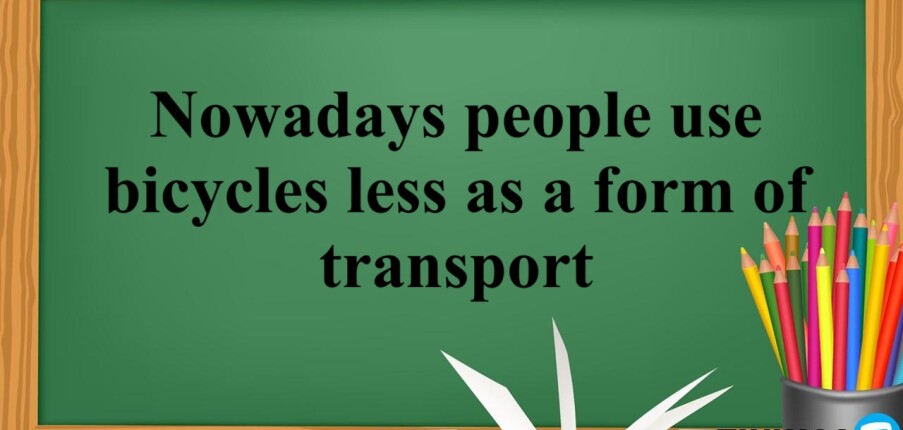Nowadays people use bicycles less as a form of transport - Đề thi IELTS Writing Task 2
Phân tích đề bài
Dạng đề: Causes and Solutions
Từ khóa: nowadays, people use bicycles less, why, encourage to use bicycles more.
Phân tích yêu cầu: Đề bài này đề cập đến xu hướng là ngày nay người ta ít sử dụng xe đạp như một phương tiện đi lại. Người viết cần phải đưa ra lý do tại sao lại có hiện tượng này và giải pháp để có thể khuyến khích mọi người sử dụng xe đạp nhiều hơn. Đối với đề bài này, chúng ta có 2 cách bố cục bài luận như sau:
- Cách 1: Thân bài thứ nhất đưa ra lý do tại sao ngày nay người ta ít sử dụng xe đạp như một phương tiện đi lại. Thân bài thứ hai sẽ đưa ra giải pháp tương ứng.
- Cách 2: Thân bài thứ nhất đưa ra lý do kèm với giải pháp đầu tiên cho việc ngày nay người ta ít sử dụng xe đạp như một phương tiện đi lại. Thân bài thứ hai đưa ra lý do kèm với giải pháp thứ hai.
Brainstorming section: Sau đây là các ý tưởng gợi ý mà người đọc có thể tham khảo để sử dụng trong bài viết của riêng mình.
|
PEOPLE USE BICYCLES LESS
|
|
CAUSES
|
SOLUTIONS
|
- Urban Sprawl and Distance: The expansion of cities can mean longer commutes that are not feasible by bicycle.
- Lack of Infrastructure: Many cities lack safe and convenient bicycle lanes or parking facilities.
- Safety Concerns: The fear of accidents due to sharing roads with faster and larger vehicles can deter people from cycling.
- Convenience and Speed: Bicycles can be seen as less convenient and slower compared to cars, especially for longer commutes or when carrying goods.
- Weather Dependency: Bicycling is often less appealing in areas with harsh weather conditions, such as heavy rain or extreme temperatures.
- Cultural and Social Factors: In many places, bicycles might be seen as a lesser mode of transportation compared to cars, which are often associated with higher social status.
- Rise of Alternative Transportation: The availability of more convenient alternatives, such as ride-sharing apps and improved public transit, may reduce bicycle usage.
|
- Improve Bicycle Infrastructure: Build more dedicated bicycle lanes, secure parking spots, and bike-sharing stations to make bicycling safer and more accessible.
- Promote Bicycle-Friendly Policies: Implement policies such as car-free zones, congestion pricing for cars, and subsidies for bicycle purchases to encourage cycling.
- Safety Campaigns and Education: Launch campaigns to educate both drivers and cyclists on road safety to reduce accidents and promote a culture of mutual respect.
- Integration with Public Transit: Facilitate the integration of bicycling with other forms of public transportation, like allowing bikes on trains or providing parking at transit stations.
- Develop and Promote Cycling Events: Organize community cycling days, races, or leisure rides to raise awareness and get more people interested in cycling as a fun activity.
- Urban Design and Planning: Design new developments to be bicycle-friendly, with amenities within cycling distance and pedestrianized areas to encourage cycling.
- Technological Innovations: Encourage the use of electric bicycles which can help people cover longer distances more easily and make cycling more appealing across different age groups and fitness levels.
|
Cấu trúc chi tiết của bài viết:
|
Mở bài
|
- Paraphrased Topic (Giới thiệu chủ đề bài viết)
- Thesis statement (Nêu lên quan điểm chính của người viết)
|
|
Thân bài 1
|
- The first cause (Nguyên nhân thứ nhất)
- Explanation (Giải thích của nguyên nhân thứ nhất)
- Example (Ví dụ cho nguyên nhân thứ nhất)
- The second cause (Nguyên nhân thứ hai)
- Consequence (Hệ quả của nguyên nhân thứ nhất)
- Example (Ví dụ cho nguyên nhân thứ nhất)
|
|
Thân bài 2
|
- The first solution (Giải pháp thứ nhất)
- Explanation (Giải thích của giải pháp thứ nhất)
- Example (Ví dụ cho giải pháp thứ nhất)
- The second solution (Giải pháp thứ hai)
- Explanation (Giải thích của giải pháp thứ nhất)
- Example (Ví dụ cho giải pháp thứ nhất)
|
|
Kết bài
|
- Restated thesis (Nhắc lại quan điểm chính của người viết)
- Summarized main points in body paragraphs (Tóm tắt lại các ý chính ở trong 2 phần thân bài)
|
Bài mẫu Tham khảo
Bài mẫu 1
In recent times, people have been using bicycles less as a primary form of transportation. This essay will discuss the reasons for this decline and propose measures to encourage more people to use bicycles.
One reason for the decline in bicycle use is the lack of proper infrastructure. Many cities lack dedicated bicycle lanes and secure parking facilities, making cycling inconvenient and unsafe. For instance, in Ho Chi Minh City, the absence of continuous bike lanes often forces cyclists to share the road with fast-moving motorbikes and cars, increasing the risk of accidents. Another factor is urban sprawl, which leads to longer commutes that are impractical by bicycle. In Hanoi, many residents live far from their workplaces due to rapid suburban development, making it challenging to rely on bicycles for daily commuting.
To increase bicycle usage, one solution is to improve infrastructure. Cities should build more dedicated bicycle lanes and provide secure parking facilities. In Da Nang, efforts have been made to create bike lanes along the Han River, encouraging more people to cycle. However, these initiatives need to be expanded nationwide. Another solution is to implement bicycle-friendly policies. Governments can offer subsidies for bicycle purchases and enforce congestion pricing for cars in city centers. In Ho Chi Minh City, the government could follow the example of European cities by providing financial incentives for purchasing electric bicycles and creating car-free zones in downtown areas to make cycling a more attractive option.
In conclusion, the decline in bicycle usage is primarily due to inadequate infrastructure and urban sprawl. By improving infrastructure and implementing supportive policies, cities can incentivize more people to embrace cycling as a sustainable and healthy mode of transportation.
Bài mẫu 2
The bar chart compares the global production of cars and bicycles from 1950 to 2000. Overall, the number of bicycles was greater than cars throughout a fifty-year period. It is also evident that of both bicycles and cars showed a general increase in numbers, reaching their peaks in 2000.
If we look at the years 1950 and 1960, we can see that a very few (not even a million) number of cars and bicycles were produced. In 1970, however, the number of bikes stood at approximately 40 million in comparison with about 5 million cars. Over the next decade, the figure for the former nearly doubled to over 100 million, while the latter one grew by 20 million.
Between 1990 and 2000, these growing trends went on, however bicycles production rose rapidly, while car production did slightly, with hitting their peaks. The cars making reached to roughly 50 million, in contrast, bike making saw a dramatic growth, with approximate 220 million.
Phân tích từ vựng
Introduction:
Decline
- Loại từ: Danh từ
- Nghĩa tiếng Anh: A gradual and continuous loss of strength, numbers, quality, or value.
- Dịch nghĩa: Sự suy giảm, sự sụt giảm
- Ví dụ:
"The decline in the quality of education in public schools is a pressing issue that needs to be addressed."
(Sự suy giảm về chất lượng giáo dục tại các trường công lập là một vấn đề cấp bách cần được giải quyết.)
Measures
- Loại từ: Danh từ
- Nghĩa tiếng Anh: A plan or course of action taken to achieve a particular purpose.
- Dịch nghĩa: Biện pháp
- Ví dụ:
"The university has taken measures to ensure the safety of students on campus."
(Trường đại học đã thực hiện các biện pháp để đảm bảo an toàn cho sinh viên trên khuôn viên trường.)
Body Paragraph 1:
Dedicated Bicycle Lanes
- Loại từ: Danh từ (Cụm danh từ)
- Nghĩa tiếng Anh: Bike lanes or paths that are reserved exclusively for cyclists, usually separated from car traffic.
- Dịch nghĩa: Làn đường dành riêng cho xe đạp
- Ví dụ:
"Many cities lack dedicated bicycle lanes, making cycling inconvenient and unsafe."
(Nhiều thành phố thiếu làn đường dành riêng cho xe đạp, khiến việc đi xe đạp trở nên bất tiện và không an toàn.)
Secure Parking Facilities
- Loại từ: Danh từ (Cụm danh từ)
- Nghĩa tiếng Anh: Parking structures or areas designed specifically to keep bicycles safe from theft and damage.
- Dịch nghĩa: Cơ sở đỗ xe an toàn
- Ví dụ:
"Many cities lack secure parking facilities, which discourages people from using bicycles."
(Nhiều thành phố thiếu các cơ sở đỗ xe an toàn, điều này khiến mọi người không muốn sử dụng xe đạp.)
Urban Sprawl
- Loại từ: Danh từ (Cụm danh từ)
- Nghĩa tiếng Anh: The uncontrolled expansion of urban areas into the surrounding rural land.
- Dịch nghĩa: Sự mở rộng đô thị
- Ví dụ:
"Urban sprawl has resulted in longer commutes that are impractical by bicycle."
(Sự mở rộng đô thị đã dẫn đến những chuyến đi trở nên dài hơn, điều này không thực tế khi đi bằng xe đạp.)
Rapid Suburban Development
- Loại từ: Danh từ (Cụm danh từ)
- Nghĩa tiếng Anh: The fast-paced growth and construction of suburban areas outside city centers.
- Dịch nghĩa: Sự phát triển nhanh chóng của khu ngoại ô
- Ví dụ:
"In Hanoi, many residents live far from their workplaces due to rapid suburban development."
(Ở Hà Nội, nhiều cư dân sống xa nơi làm việc do sự phát triển nhanh chóng của khu ngoại ô.)
Daily Commuting
- Loại từ: Danh từ (Cụm danh từ)
- Nghĩa tiếng Anh: The act of traveling to and from work or school on a regular basis.
- Dịch nghĩa: Việc đi lại hàng ngày
- Ví dụ:
"Urban sprawl has made daily commuting by bicycle challenging for many residents."
(Sự mở rộng đô thị khiến việc đi lại hàng ngày bằng xe đạp trở nên khó khăn đối với nhiều cư dân.)
Body Paragraph 2:
Secure Parking Facilities
- Loại từ: Danh từ (Cụm danh từ)
- Nghĩa tiếng Anh: Parking structures or areas designed specifically to keep bicycles safe from theft and damage.
- Dịch nghĩa: Cơ sở đỗ xe an toàn
- Ví dụ:
"Many cities lack secure parking facilities, which discourages people from using bicycles."
(Nhiều thành phố thiếu các cơ sở đỗ xe an toàn, điều này khiến mọi người không muốn sử dụng xe đạp.)
Implement Bicycle-Friendly Policies
- Loại từ: Động từ (Cụm động từ)
- Nghĩa tiếng Anh: To introduce and enforce rules and regulations that support and encourage cycling.
- Dịch nghĩa: Thực hiện các chính sách thân thiện với xe đạp
- Ví dụ:
"Governments should implement bicycle-friendly policies to make cycling a more attractive option."
(Chính phủ nên thực hiện các chính sách thân thiện với xe đạp để khiến việc đi xe đạp trở nên hấp dẫn hơn.)
Enforce Congestion Pricing
- Loại từ: Động từ (Cụm động từ)
- Nghĩa tiếng Anh: To implement a system where drivers are charged for entering certain high-traffic areas to reduce congestion.
- Dịch nghĩa: Thực thi thu phí chống ùn tắc
- Ví dụ:
"Governments can enforce congestion pricing for cars in city centers to reduce traffic."
(Chính phủ có thể thực thi thu phí chống ùn tắc đối với ô tô ở trung tâm thành phố để giảm lưu lượng giao thông.)
Financial Incentives
- Loại từ: Danh từ (Cụm danh từ)
- Nghĩa tiếng Anh: Monetary benefits offered to encourage a particular action or behavior.
- Dịch nghĩa: Các ưu đãi tài chính
- Ví dụ:
"In Ho Chi Minh City, the government could provide financial incentives for purchasing electric bicycles."
(Ở Thành phố Hồ Chí Minh, chính phủ có thể cung cấp các ưu đãi tài chính cho việc mua xe đạp điện.)
Car-Free Zones
- Loại từ: Danh từ (Cụm danh từ)
- Nghĩa tiếng Anh: Areas where motor vehicles are restricted or completely prohibited, allowing only pedestrians and cyclists.
- Dịch nghĩa: Khu vực không có xe hơi
- Ví dụ:
"Establishing car-free zones in downtown areas can make cycling more attractive."
(Việc thiết lập các khu vực không có xe hơi ở khu vực trung tâm có thể khiến việc đi xe đạp trở nên hấp dẫn hơn.)
Conclusion:
Inadequate Infrastructure
- Loại từ: Danh từ (Cụm danh từ)
- Nghĩa tiếng Anh: Insufficient or substandard physical structures and facilities needed for transportation or other services.
- Dịch nghĩa: Cơ sở hạ tầng không đầy đủ
- Ví dụ:
"The decline in bicycle usage is primarily due to inadequate infrastructure and urban sprawl."
(Sự suy giảm trong việc sử dụng xe đạp chủ yếu là do cơ sở hạ tầng không đầy đủ và sự mở rộng đô thị.)
Incentivize
- Loại từ: Động từ
- Nghĩa tiếng Anh: To provide incentives or rewards to encourage a particular action or behavior.
- Dịch nghĩa: Khuyến khích bằng cách đưa ra ưu đãi
- Ví dụ:
"Governments can incentivize the use of bicycles by offering subsidies and financial rewards."
(Chính phủ có thể khuyến khích việc sử dụng xe đạp bằng cách đưa ra các khoản trợ cấp và phần thưởng tài chính.)
Xem thêm các tài liệu Tiếng Anh hay, chi tiết khác:
TOP việc làm "HOT"dành cho sinh viên



